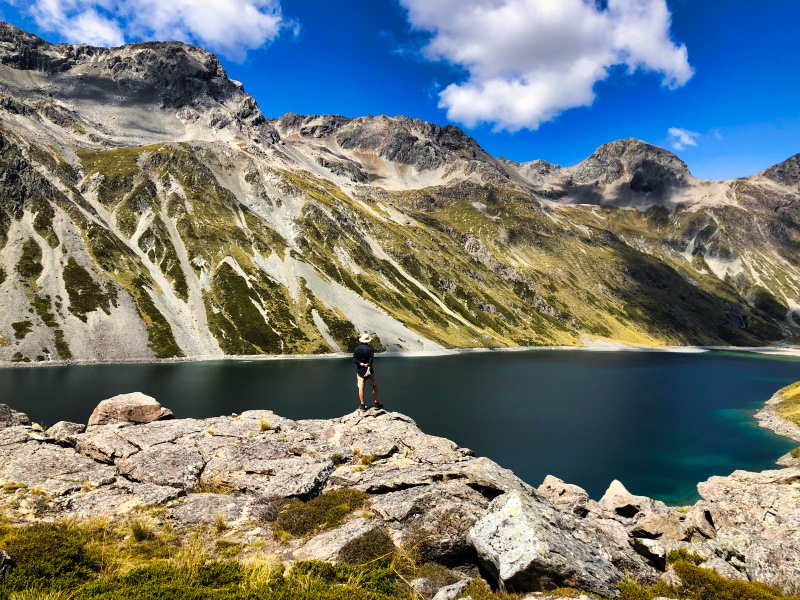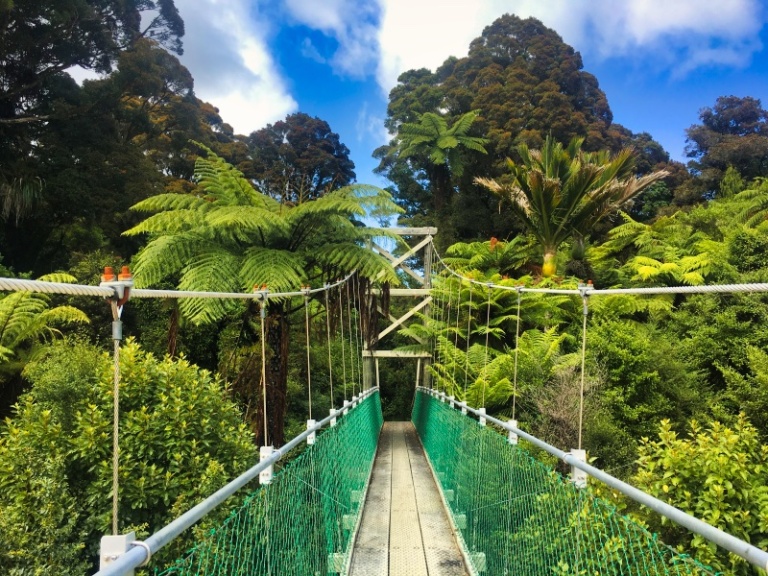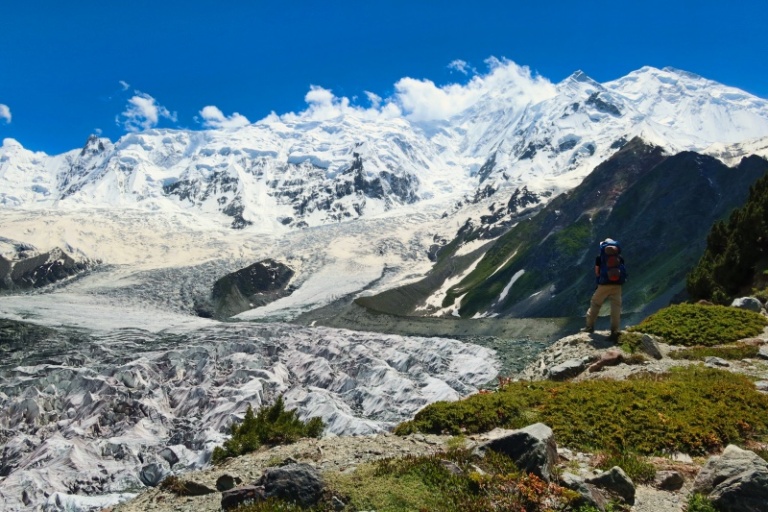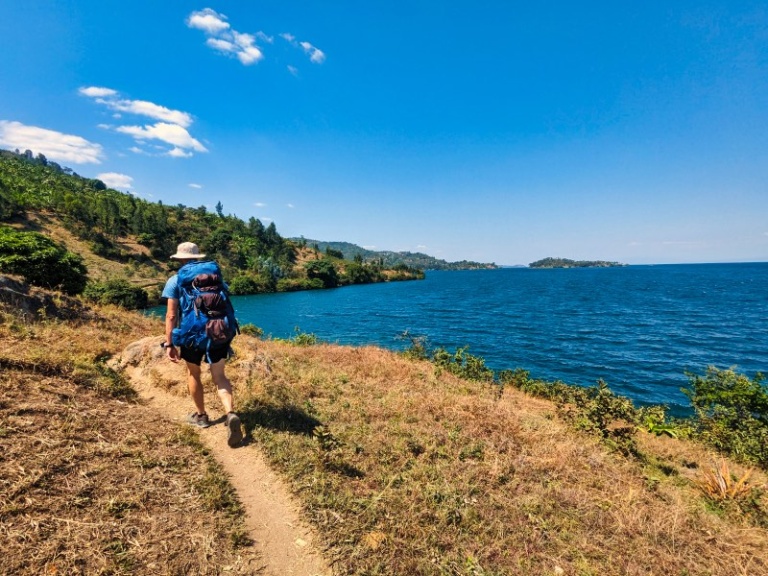The Ultimate Guide to the Travers Sabine Circuit (2024)
Situated near the top of the south island, the Travers Sabine Circuit features all you can ask for in a New Zealand hike: dense beech forests, babbling brooks, alpine scenery and crystal clear lakes. It’s a challenging trek, but the payoff is incredible.
And while the word is out about this very special hike, it’s still not nearly as popular as the better-known Great Walks, so you won’t have to worry about fighting off the crowds.
Read on for our complete guide to the Travers Sabine Circuit, featuring all the information you need to get yourself organised and complete this epic hike.
New Zealand Travel Resources
- Getting there: search for flights to New Zealand
- Guidebook: pick up a Lonely Planet New Zealand guidebook
- Where to stay: search for hostels and hotels
- Getting around: search for buses
- Rent a car: search for deals on car rentals
- Travel insurance: get travel insurance for your trip
- Money: get a Wise travel card to save big time in New Zealand
- Tours: check out the best New Zealand tours
Travers Sabine Circuit Overview
- Location: Nelson Lakes National Park, Nelson/Tasman Region, South Island
- Length: 80 – 100 km (depending on side trips)
- Time: 4 – 8 days
- Season: November – April
- Gateway city: Nelson
- Type: Circuit
- Booking Required: No
- Sleeping: Camping or huts
- Start: Kerr Bay or Mount Robert Car Park
- Finish: Mount Robert Car Park
- Difficulty: Moderate to demanding
- What to expect: Grassy flats, beech forests, raging rivers and waterfalls, a high alpine pass and a side trip to one of the world’s clearest lakes – oh yeah and lots of tree roots and rocks!
Travers Sabine Circuit Location

The Travers Sabine Circuit is located on the south island of New Zealand in Nelson Lakes National Park. Nelson Lakes National Park is located just outside of the teeny tiny village of St Arnaud, which is 81 km south of Nelson.
There’s not a lot going on in St Arnaud, and not much in the way of supplies, so Nelson is the best place to base yourself to get organised for hiking the Travers Sabine Circuit.
Looking for more great hikes near Nelson? Check out the Heaphy Track
Travers Sabine Circuit: The Trail
The Travers Sabine Circuit is an 80 km circuit comprised of 7 sections that goes deep into the heart of Nelson Lakes National Park and is easily one of the best hikes in Nelson Lakes National Park (if not the best).
The circuit crosses some of the park’s most magnificent scenery: beech forests, crystal clear lakes and rivers and a high alpine crossing that can freeze at any time of the year.
There are a number of ways in which you can hike the Travers Sabine Circuit: you can just bag a section or two (with the assistance of the water taxi), mix and match sections, walk the entire circuit or walk the entire circuit plus a few fun additional trips. The choice is yours, my friend.
The Blue Lake Track is an additional section from West Sabine Hut to Blue Lake Hut that can be added to any Travers Sabine itinerary (and is highly recommended!). With a measured 80m of visibility, Blue Lake is thought to be the clearest fresh water in the world. It’s also a sacred Maori location and highly worth a visit.
Read our full guide on How to Visit Blue Lake Nelson

The Best time to do the Travers Sabine Circuit
The best time to do the Travers Sabine Circuit is from December to February. This is during New Zealand’s summer and you can expect warm days with pleasant evenings. Do note that as this is an alpine region, and New Zealand has temperamental weather, heavy rain can occur at any time and nights can get very cool, even in summer.
The official season for hiking the Travers Sabine Circuit is from November to April. During the shoulder months of November, March and April, days will be cooler, nights much colder and rain more frequent.
Unless you are a very experienced mountaineer with navigation and alpine skills, it is not recommended to hike the Travers Sabine Circuit in winter. Snow is present on the high passes and there is a high risk of avalanches on certain parts of the trail.
Related: The Complete Guide to Hiking Mt Arthur
Transportation to the Travers Sabine Circuit and Blue Lake Track
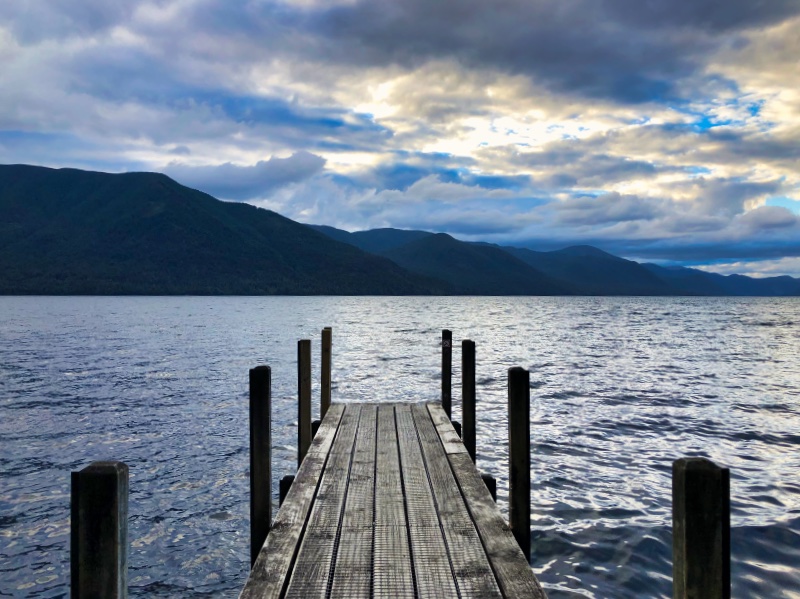
Nelson to St Arnaud
To begin the Travers Sabine Circuit hike, you must first get to St Arnaud. From Nelson, you can get to St Arnaud by your own car, hitchhiking, or a shuttle.
Car
If you have your own wheels, it’s an easy, 1.5 hour drive to St Arnaud from Nelson. You can park your car either at Kerr Bay or the Mount Robert Car Park.
Don’t have your own set of wheels and need to rent a car? We personally use and recommend Discover Cars.
Hitchhiking
New Zealand is not Europe and public transport is limited, but fortunately, there are options on how to get around New Zealand without a car.
If you don’t have your own set of wheels, you can always try your hand at hitchhiking to/from the trailhead.
Hitchhiking, especially among hikers, is relatively common in NZ, so drivers are used to seeing and picking up people who need lifts. However, that said, there seems to have been an increase in hitchhikers in recent years, meaning increased competition for a valuable seat.
As a note of confidence, if you try early enough, you should be able to get a ride in either direction. We hitchhiked from St Arnaud to Nelson at the end of the Travers Sabine Circuit, and despite having to wait 3 very long hours, did manage to get a lift.
Trek Express Shuttle
Trek Express offers shuttle services from Nelson to many of the surrounding trailheads, including both St Arnaud and Mount Robert Car Park. Prices range from $30 – $65 pp and a minimum of 5 people are needed to make a trip.
Trek Express has a helpful ‘existing trips’ page on its website where you can find a list of upcoming trips to join if you don’t have the requisite numbers to charter a shuttle.
St Arnaud to the Travers Sabine Circuit Trailhead
Once you are in St Arnaud, you must then get to either Kerr Bay or Mount Robert car park (depending on how you are starting the circuit).
Kerr Bay is a 5-minute walk from the DOC visitor’s centre in St Arnaud. Simply head down Kerr Bay Road towards the lake and you’ll find the trailhead easily.
Mount Robert car park is a further 6 km up the hill from St. Arnaud. If you are starting the Traver Sabine Circuit from here, you can drive and park your car, walk or hitch a lift. It takes approximately 1.5 hours to walk to this trailhead from town.
Read next: The Complete Guide to the Tableland Circuit
How much does it cost to do the Travers Sabine Circuit and Blue Lake Walk?
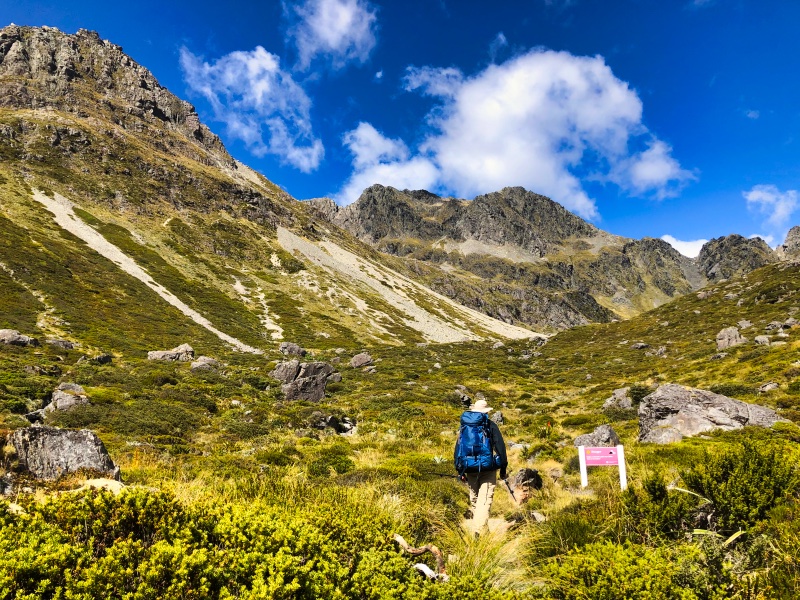
There are no fees to enter New Zealand National Parks or to use the trails. Yes, that even includes the best hikes in Nelson Lakes National Park.
You must pay to use the huts and/or for camping within 50m of a hut. All huts on the Travers Sabine Circuit cost $25 NZD pp per night (excluding Angelus Hut, if you choose to incorporate this on your walk). Camping outside any of the huts costs $10 NZD.
Outside of these fees, you will also have to pay for your food, supplies and transportation to/from St Arnaud.
To give you an idea of expected costs, when we did the Travers Sabine Circuit (including one night at Angelus Hut) in early 2023, we paid $260 NZD for 6 nights of huts for both of us. We also paid around $220 NZD for food and gas for our stove. Our total expenses for a 6-night/7-day trek for 2 people came to approximately $480 NZD. Please note that at this time, the huts only cost $20 NZD per night.
How difficult are the Travers Sabine Circuit and the Blue Lake Track?
Overall, the Travers Sabine Circuit is a pretty demanding hike. (It’s not one of the best hikes in Nelson Lakes National Park for nothing). The terrain is super challenging: the track is mostly unformed, with plenty of big tree roots and stones on the path that requires constant attention to navigate.
There are plenty of steep sections to ascend and descend, as well as sections of mud and slippery river crossings.
To successfully hike the Travers Sabine Circuit, you need a good level of physical fitness and previous hiking experience.
The Blue Lake Track is equally challenging. The hike from West Sabine Hut to Blue Lake Hut, while short (at around 8 km), is steep, with almost 600m of elevation gain. The track is technical at times and requires climbing over steep rocks and boulders.
What to expect on the Travers Sabine Circuit
Huts
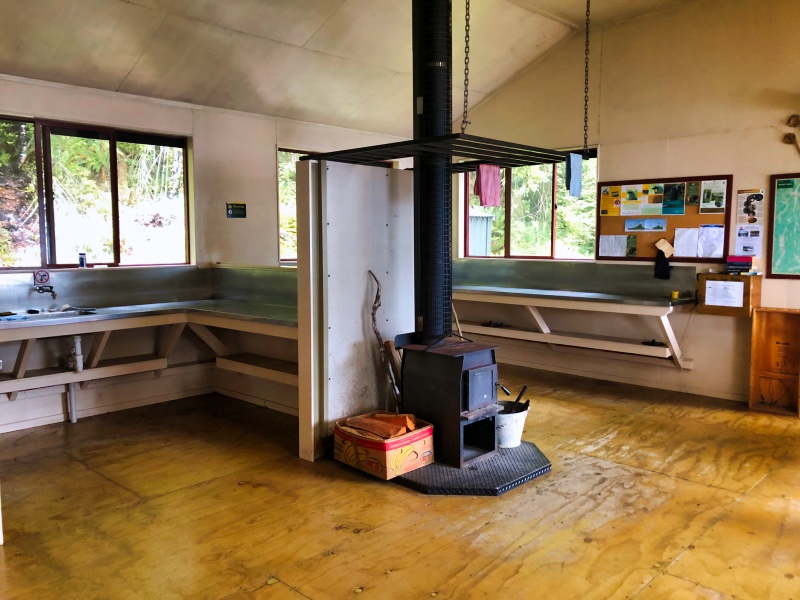
There are 7 huts on the Travers Sabine Circuit, plus the Blue Lake Hut as well. These huts cannot be booked and operate on a first-come, first-served basis.
Except for Coldwater Hut, all huts on the Circuit (including Blue Lake Hut), are serviced huts. This means they have mattresses, water supply, toilets, hand-washing facilities (but usually not soap) and a fireplace for heating.
The huts do not have cooking facilities (i.e., gas) so ensure you bring your own supplies. Fuel canisters can be purchased around Nelson at a number of places, but we found MD Outdoors to have the best prices.
None of the huts have electricity (i.e., lighting), so people usually go to bed and wake up with the sun’s natural cycle. A headlamp is useful!
It’s also worth noting that none of the toilets have toilet paper, so do make sure you bring your own.
In peak hiking season, the huts can become quite busy. Fortunately, people are generally respectful and staying in a hut is a great opportunity to meet some interesting people from all around the world.
How to pay for huts and camping along the Travers Sabine Circuit
Although you cannot book any of the huts on the Travers Sabine Circuit in advance, you must pay for your huts in advance.
To stay in the huts along the Travers Sabine Circuit and at Blue Lake Hut, you must purchase Backcountry Hut Tickets from any Department of Conservation (DOC) office. The DOC office in Nelson is centrally located and has very helpful staff who can answer any questions you may have.
Each hut along the Travers Sabine Circuit and Blue Lake hut requires 1 x blue ticket and 1 x green ticket each. When you’re at the hut, simply fill in the dates on the tickets and put the stubs in the honesty box inside the hut. Hut wardens may come to inspect your tickets to ensure you’ve paid.
Camping
There is abundant camping along the Travers Sabine Circuit and at Blue Lake Hut.
Each hut has a designated camping area. It costs $10 to camp within 50m of a hut. To pay for this, purchase a blue ticket in advance (see above) and put it in the honesty box at the hut.
You can wild camp for free anywhere along the trail, so long as it isn’t within 50m of a hut. There are numerous great spots along the trail. Just beware the sandflies!
Weather

The weather on the Travers Sabine Circuit will depend on which season you hike in.
If you do the Travers Sabine Circuit during the summer, from December to February, then you can expect warm days and mild evenings.
That said, the weather in New Zealand’s mountains is fickle and can change at any time: heavy rain and freezing conditions can occur, even in summer. Be sure to pack appropriately! Don’t worry, we’ve got you covered – see our packing list below.
In winter, the Travers Sabine Circuit can be snowbound, crampons are required and avalanches are common.
Water
Generally speaking, water is abundant on the Travers Sabine Circuit and you never have to carry much at any given time. There are a few notable areas where water is scarce, which we have outlined in the relevant sections.
Any running water found along the Travers Sabine Circuit is generally safe to drink and doesn’t need to be treated – it’s also usually delicious!
You should treat all water at the huts, however, as this is sitting rainwater and can be contaminated by bird and possum droppings.
Pro tip: for treating water on all our hikes, we use a Steripen – it’s a game-changer.
Food
There are no facilities to purchase food on the Travers Sabine Circuit or at Blue Lake Hut, so you must bring all the food you need for the duration of your trek.
Backcountry meals are very popular, because they are light and easy to prepare, if not a bit expensive. They can be purchased at many places in Nelson, including the supermarket and speciality outdoor stores. We prefer the Radix Meals, which can be found at MD Outdoors.
If you would like to prepare your own food, instant noodles, pouches of beans, chickpeas and tuna, couscous and instant pasta packages are all great options.
Pro tip: add dehydrated shitake mushrooms to your meals. They’re lightweight and have a lot of nutrition. They can be purchased at the supermarket and need to be soaked in cold water for 20 minutes before being cooked. (We actually discovered this trick whilst watching other hikers on the Heaphy Track).
Rubbish

Pack it out, folks! Make sure to bring a bag to collect your garbage and take it out with you. Please, please do not throw your rubbish out on the trail or leave it in the huts.
Pro tip: to minimise rubbish on the trail, decant as much of your food beforehand as possible.
Safety
Even though the Travers Sabine Circuit have good facilities and a well-marked trail, it is still a relatively isolated trek. We highly recommend walking with a personal locator beacon (PLB) or similar device in case of any emergencies.
Hiking is an adventure, so make sure you have travel insurance!
Travel insurance, as always, is essential. If something goes wrong, you want to be covered. We use and recommend SafetyWing. Trust us, we’ve used a lot of travel insurance and they really are the best.
Navigation
It is pretty easy to navigate the Travers Sabine Circuit. There are numerous, clear trail markers along the trail which are easy to follow.
Below the bush line, the trail markers are orange triangles nailed to trees. Above the bush line, they are poles with an orange top.
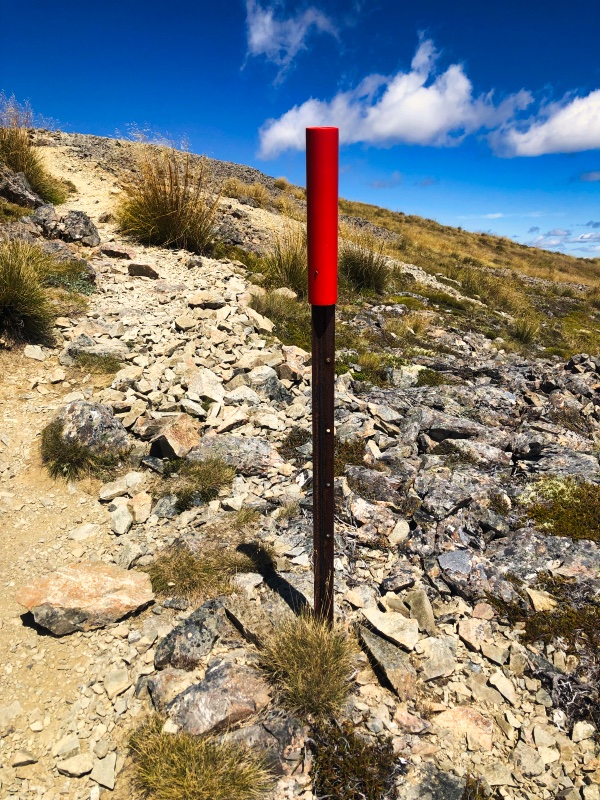
You don’t need a physical map, but it is a very good idea to download the maps.me trail in advance. If you would like to purchase a physical map of the Travers Sabine Circuit, you can do some from the DOC office in Nelson.
Mobile Reception and Electronics
There is very limited mobile reception along the Travers Sabine Circuit, so do not depend on it. You can normally only access it from a few high points.
There are no places for charging your electronics on the trail, so we recommend bringing a power bank to keep your devices fully juiced.
Travers Sabine Circuit Section Breakdown
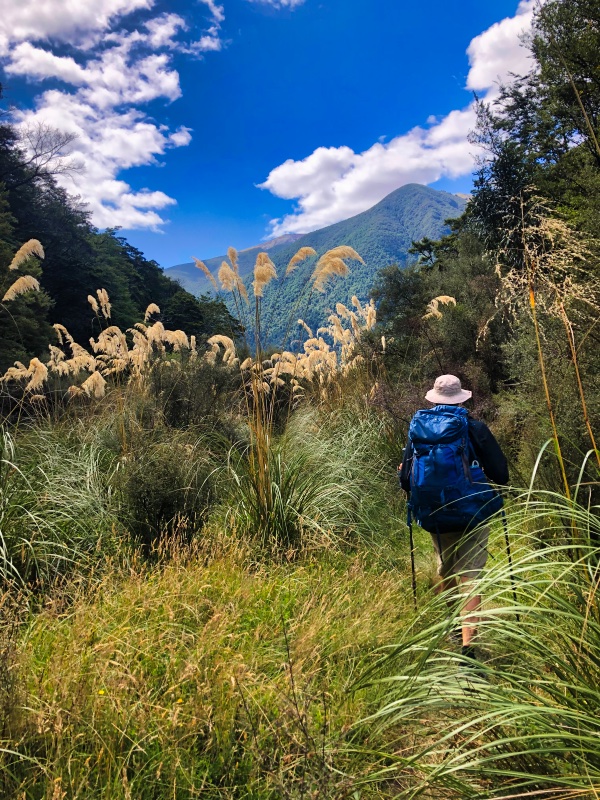
Section 1: St Arnaud to Lakehead Hut / Coldwater Hut
- Distance: 10 km
- Time: 2.5 – 3 hours
- Elevation: none
- Difficulty: Easy
Beginning at the eastern end of the bay, the track gently wanders through the forest. There are several small beaches to rest along the way.
Lakehead Hut (28 bunks), is reached around 2 – 3 hours (9km) from Kerr Bay and is on a grassy bank overlooking the Travers River.
Coldwater Hut (12 bunks), which is smaller and older (but has better views), is about 800m away across the Travers River on the other side of the lake.
Section 2: Lakehead Hut / Coldwater Hut to John Tait Hut
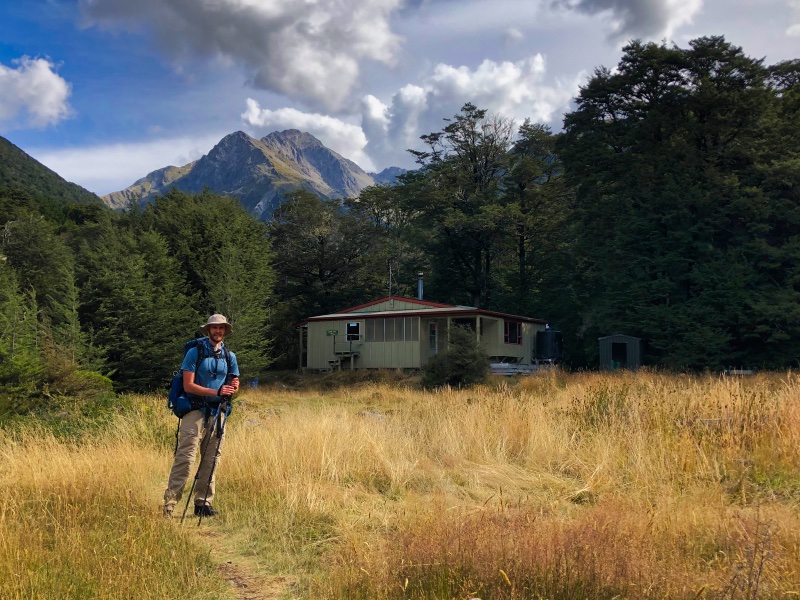
- Distance: 14 km
- Time: 4 – 5 hours
- Elevation: + 200m
- Difficulty: Easy
At Lakehead Hut, signposts direct you across the Travers River and through a grassy flat to the walking track on the true left (west) side of the river. There is an alternative in high water, but the left side is more scenic.
You will soon pass a signposted junction for Cascade Track which leads to Angelus Hut (this is a great way to incorporate the Lake Angelus Track into the circuit). Just past the junction is a flat area good for lunch or camping.
30 minutes after the junction is a swing bridge across the Travers River. Do not cross the bridge. Stay on the true left side of the river.
After 3.5 km, you’ll emerge onto another flat, with Mt Travers dominating the view.
Just beyond the edge of the flat, you arrive at another swing bridge over Hopeless Creek. Cross this swing bridge.
On the other side is a signposted junction to Hopeless Hut (this is about 1.5 hours after the junction).
From here, it’s another 1.5 hours of easy walking to John Tait Hut.
John Tait Hut (27 bunks) is set in a small grassy clearing with good views of the peaks at the head of the valley. It’s a decent hut but not the most picturesque on the Travers Sabine Circuit. For this reason, it’s also not nearly as popular as the other ones – meaning you may just get it to yourself.
Section 3: John Tait Hut to Upper Travers Hut
- Distance: 6 km
- Time: 2.5 – 3 hours
- Elevation: + 510m
- Difficulty: Easy to moderate
From John Tait Hut, the track continues to climb up the valley.
After about 45 minutes of walking, you pass a sign marking the turn-off for Travers Waterfall (a 3 minute detour). Leave your packs and enjoy the beautiful cascade, which drops 20m into a clear, blue pool. If you have time, you can walk down to the base of the waterfall.
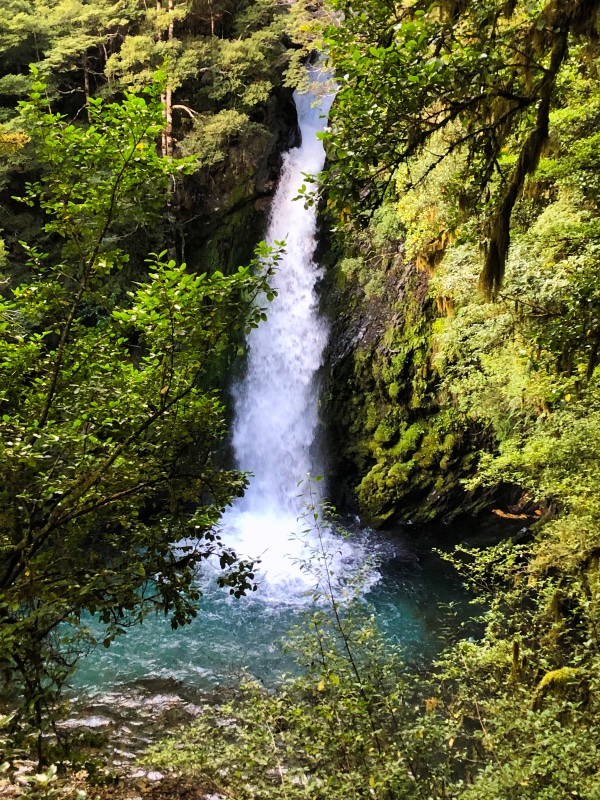
After the waterfall, the gradient eases slightly until you cross the Travers River over a bridge.
At this point, you begin an even steeper climb to the bush line. At the edge of the bush line, about 2 km from the bridge, there are good views of the peaks of both the Travers Range and St Arnaud Range.
Upper Travers Hut (24 bunks) sits at the base of the pass, at 1340m. It’s a super cute and photogenic hut and a great spot for either a break or to spend the night before conquering the Travers Saddle.
Section 4: Upper Travers Hut to West Sabine Hut
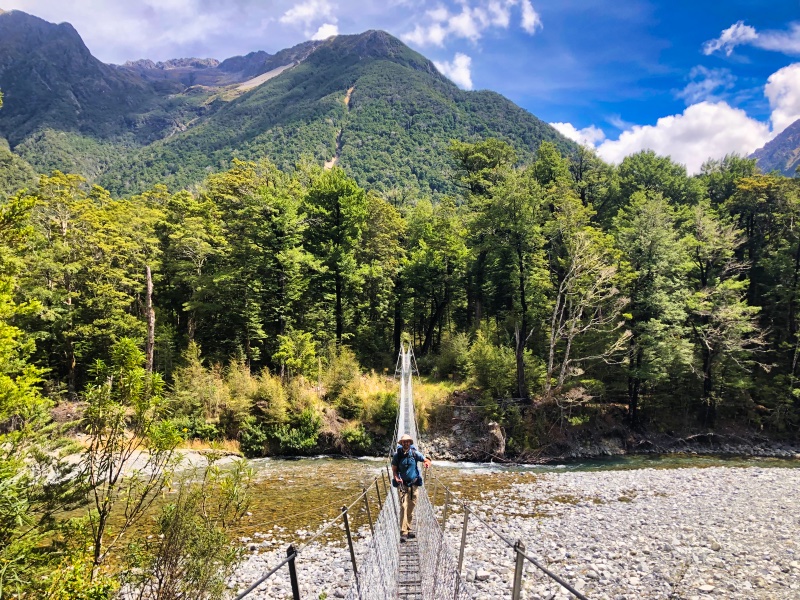
- Distance: 8 km
- Time: 5 – 6 hours (more in winter)
- Elevation: + 470m / – 1120m
- Difficulty: Difficult
From Upper Travers Hut, you begin the climb up the pass.
The route climbs gently towards the saddle for 1 km, at which point it begins to zigzag. After 1.5 hours, you reach Travers Saddle (1787m).
The top is marked by a large cairn with a pole in it. As far as mountain passes go, it’s pretty manageable.
It’s a beautiful spot, but for truly great views, you should scramble to one of the nearby ridges (if you have time).
From the saddle, you begin a very steep 1000m descent to Sabine Forks. The first part is okay, and then it begins to get rougher.
After 1 hour of descending, you reach the bush line – this is where things get really crazy. It’s a really rough descent that takes another 1.5 hours to bottom out at the river.
After reaching the river, the track undulates for about 2 km. It feels very cruel to climb again after such a steep descent. There’s another steep drop that takes about 20 – 30 minutes and then you reach West Sabine Hut.
West Sabine Hut (30 bunks) is just okay and not in a particularly scenic location. Because of Blue Lake’s popularity and the number of day trippers on the Blue Lake Track, it can be very crowded. The sandflies here are also particularly horrific.
There are good camping spots near West Sabine Hut, but also at the river where the track bottoms out.
Note on water for this section: approaching the saddle, there is running water until 1 hour up. After this, there is no water until you reach the river – about 3 hours total hiking time. Plan accordingly.
Additional Section: West Sabine Hut to Blue Lake Hut
- Distance: 7.5 km
- Time: 3 – 3.5 hours
- Elevation: + 520m
- Difficulty: Moderate to difficult
The section to Blue Lake Hut is a highly recommended addition to the Travers Sabine Circuit.
The Blue Lake Track is a manageable section with 2 steep and challenging parts.
After about 2 hours of hiking, the valley opens up with views of Moss Pass and Mt Cupola (2260m). This has some of the best scenery on the entire Travers Sabine Circuit.
The Blue Lake Track then goes back into the bush and becomes much steeper. At one point, you climb a series of large and slippery rocks parallel to the raging river.
Blue Lake Hut (16 bunks) is set above the lake near the bush line and is a beautiful spot to spend the night.
Blue Lake is thought to be the clearest freshwater lake in the world, with 80m of visibility. In comparison, pure, distilled water has a visibility of 83m.
Important: You are not allowed to contaminate the lake in any way – this means no swimming, drinking from or even camping near the lake (you can camp near the hut).
You can bathe yourself from the point at which the water exits Blue Lake – there will be signs pointing in the right direction. The water here tastes delicious.
We highly recommend hiking to the viewpoint of Lake Constance. It is around 1 km with 220m of elevation gain and takes 45 minutes (with no packs).
This has some of the most incredible mountain scenery in the entire Nelson Lakes National Park, plus aerial views of Blue Lake and Lake Constance.
Be sure not to ascend the scree towards the Waiu Pass!
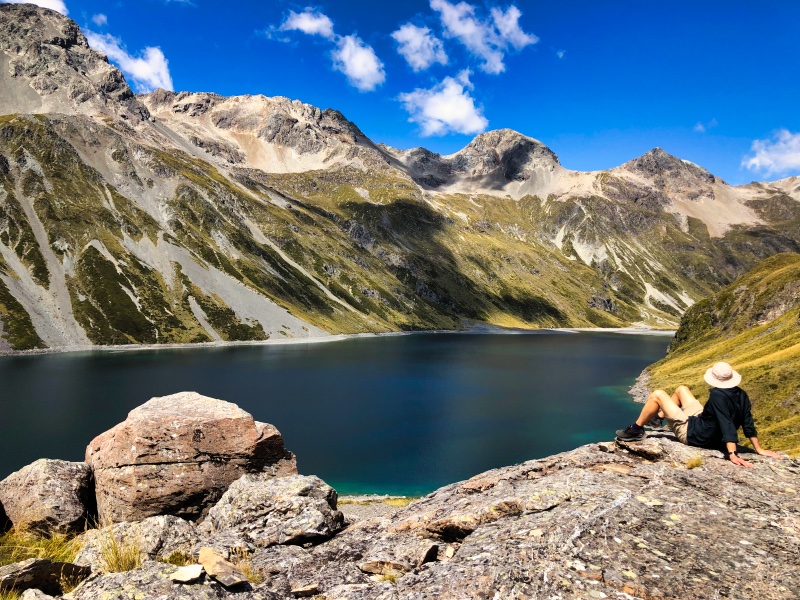
Section 5: West Sabine Hut to Sabine Hut
- Distance: 15 km
- Time: 4.5 – 5 hours
- Elevation: – 230m
- Difficulty: Moderate
From West Sabine Hut, it is pretty tough going as the trail is pretty rocky with lots of exposed tree roots. The trail undulates a lot, with some flat sections in tussock.
Overall, it’s not a particularly scenic section – except for one major highlight. About 40 minutes before you reach Sabine Hut, the trail crosses a bridge over a stunning aquamarine gorge. The water here is some of the most beautiful we have ever encountered.
If you look around, you will find a rock about 2 – 3 m above the water that is an ideal spot for safely jumping from. It’s a great way to finish the day. You can swim to the bank, where there is a trail up.
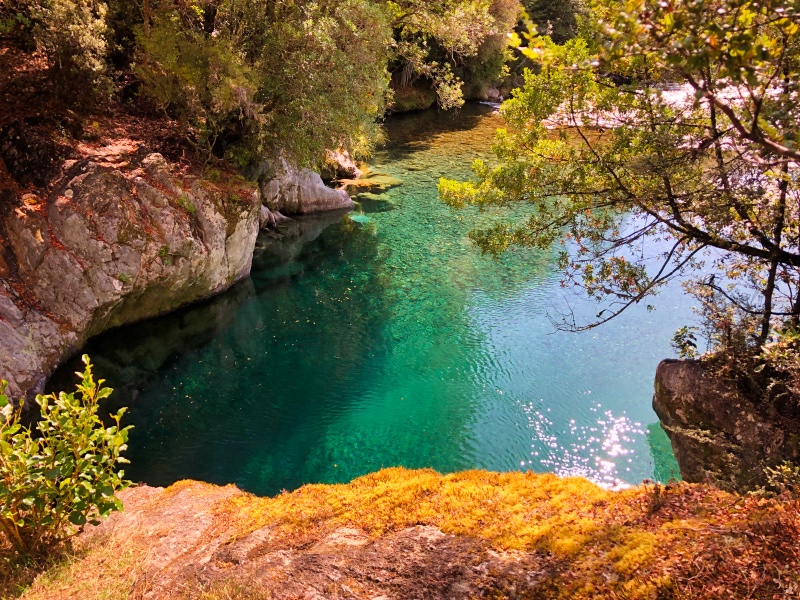
Sabine Hut (32 bunks) is wonderful, with incredible views of Lake Rotorua. Despite the abundance of sandflies, it’s an inviting place to spend the night. The large picture windows allow you to enjoy the view bite-free. You can also enjoy sunsets over the lake from the hut’s jetty.
Note that from Sabine Hut, you can finish the hike early by taking the Rotoroa Water Taxi to Rotoroa Village. This costs $65 per person with a minimum charge of $200.
Section 6: Sabine Hut to Speargrass Hut
- Distance: 11 km
- Time: 4 hours
- Elevation: + 605m / – 115m
- Difficulty: Moderate
The section starts with a moderate climb with occasional views of the lake. Once topping out, the trail undulates a little, with some flat sections in there as well.
At the top, there is a boardwalk for what seems like forever, with the cute addition of a benched rest area (with 4G reception!).
The trail opens up into a wide path, which leads down the hill into the flat, where you’ll find Speargrass Hut (12 bunks). Speargrass Hut is super cute with nice views of the mountains and tussock. The sandflies at the hut are also not terrible, allowing you to enjoy the veranda.
Section 7: Speargrass Hut to Mount Robert Car Park
- Distance: 6.5 km
- Time: 2.5 – 3 hours
- Elevation: + 80m / – 180m
- Difficulty: Moderate
For a section that is supposed to be mostly descent, it annoyingly undulates a lot. The track is mostly roots and boulders under the bush canopy.
After rain, it can be very muddy and boggy.
Travers Sabine Circuit Itineraries
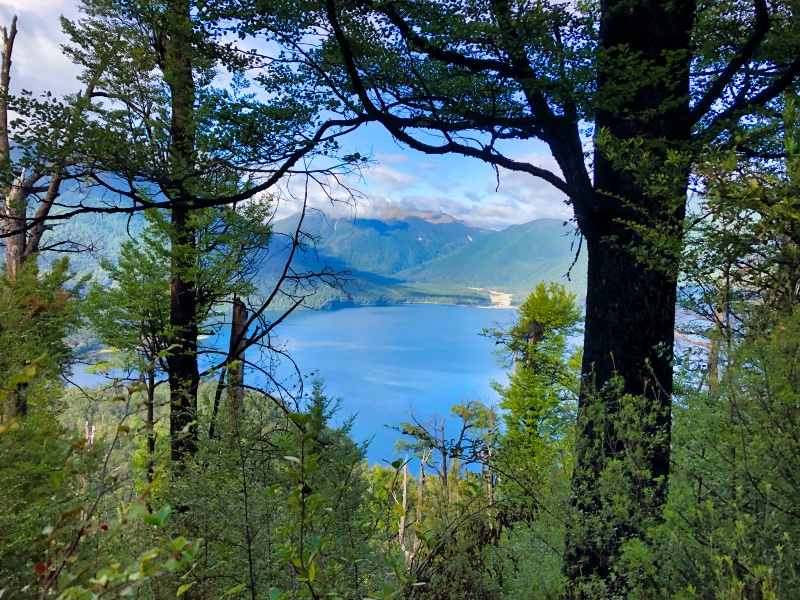
There are a number of itineraries that you can design to hike the Travers Sabine Circuit. In addition to just the Travers Sabine Circuit, you can include the Blue Lake Track, as well as hiking to Angelus Hut (another stunning hut in Nelson Lakes National Park).
Itinerary without Angelus Hut
If you do not want to include Angelus Hut, we recommend the following itinerary:
Day 1: Kerr Bay to Lakehead Hut
Day 2: Lakehead Hut to Upper Travers Hut
Day 3: Upper Travers Hut to West Sabine Hut
Day 4: West Sabine Hut to Blue Lake Hut (+ walking up to Lake Constance Viewpoint)
Day 5: Blue Lake Hut to Sabine Hut
Day 6: Sabine Hut to Speargrass Hut
Day 7: Speargrass Hut to Mount Robert Car Park
This itinerary allows you to stay in some of the best huts and enjoy the Travers Sabine Circuit at a good pace.
This itinerary can easily be shortened by removing day 7 and finishing on day 6. If you do this option, it is best to have your transport arranged as you will arrive at Mount Robert Car Park in the mid-late afternoon, which can make hitchhiking back tricky.
Itinerary with Angelus Hut
If you would like to incorporate Angelus Hut into the Travers Sabine Circuit (as we did), you can do so by adding it at either the start or the finish. As bookings are required for Angelus Hut, it is easier to include it at the start, when you have certainty.
To include Angelus Hut, we recommend the following itinerary:
Day 1: Mount Robert Car Park to Angelus Hut (via Robert Ridge)
Day 2: Angelus Hut to John Tait Hut (via the Cascade Track)
Day 3: John Tait Hut to West Sabine Hut
Day 4: West Sabine Hut to Blue Lake Hut (+ walking up to Lake Constance Viewpoint)
Day 5: Blue Lake Hut to Sabine Hut
Day 6: Sabine Hut to Speargrass Hut
Day 7: Speargrass Hut to Mount Robert Car Park
Whatever itinerary you choose, do know that the Travers Sabine Circuit is best walked from the Travers side to the Sabine side, because crossing the Travers Saddle is much easier from the Travers side.
Tips and tricks
- Bring hiking poles. They’re not only useful for the ascents and descents but testing rock stability, and mud depth and for helping cross rivers and streams.
- Make sure your boots have Gore-Tex. This will greatly help with the water crossings.
- Get to Blue Lake Hut early in the day. The Blue Lake walk is quickly gaining popularity, so you’ll want to secure a bunk early – plus have time to explore this beautiful area.
- From Blue Lake Hut, walk up to the view of Lake Constance. This is one of the best views in the entire national park.
- Bring earplugs for the huts. Trust us on this.
- Bring sandals, crocs or any comfortable footwear for the huts. Your feet will thank us.
What to Pack for the Travers Sabine Circuit
Gear
- Good quality hiking backpack (men’s and women’s)
- Raincover for backpack
- Tent
- Sleeping pad
- Blow up pillow
- Sleeping bag
- Waterproof compression bag (for the sleeping bag)
- Stuff sack (for keeping clothes in while hiking)
- Headlamp
- Ground blanket
- Dry bag
- Trekking poles
- Personal locator beacon (PLB)
Women’s Clothing
- Hiking boots
- Hiking pants
- Hiking top
- Long sleeve hiking shirt
- Merino underwear
- Sports bra
- Lightweight Merino socks (I’m a fan of wearing two pairs when hiking)
- Warm socks to wear at camp
- Fleece
- Down jacket
- Rain jacket
- Gloves
- Beanie / Toque
- Thermal top
- Thermal leggings
- Waterproof sandals
- Sunglasses
- Hat
- Buff
Men’s Clothing
- Hiking boots
- Hiking pants/shorts
- Sports t-shirt
- Merino underwear
- Lightweight Merino socks (also a fan of the double socks)
- Fleece
- Thermal top
- Thermal bottoms
- Down jacket
- Gloves
- Beanie / Toque
- Waterproof sandals
- Sunglasses
- Buff
- Hat (full-brimmed)
Cooking
- Camp stove
- Cooking set (pot, bowls and mugs)
- 1 x 230 grams fuel canister
- Collapsible tea kettle (a luxury, but it’s worth it!)
- MSR MugMate Coffee Filter
- Spork
- Pocket knife
- Lighter and matches (in a waterproof bag)
- Water bladder
- Water bottle
Sanitation
- Steripen Ultra Rechargeable Portable UV
- Hand sanitiser
- Toilet paper
- The Deuce Backpacking Potty Trowel
- Hydralites / Electrolytes (if you can’t find, salt and powdered juice packets work a treat)
- Biodegradable dish soap
- Mini sponge (just cut a regular one)
- Rubbish bags
- Dettol spray or bug spray
Personal
- Eye mask
- Ear plugs
- Toothbrush
- Biodegradable toothpaste
- Deodorant paste (decanted into a small container)
- Blister first aid kit
- First aid kit
- Sunscreen
- Lip balm with SPF
- Book / kindle
- Games to play at camp – deck of cards, or our favourite, Yahtzee
Electronics
- Phone and charging cables
- Power bank and/or solar panel
- Camera and/or GoPro plus charging cords
Where to stay in Nelson before and after hiking the Travers Sabine Circuit
Budget
Mid-range
High-end
Like this post? Pin it for later!

Disclaimer: This post contains affiliate links. This means that if you buy or book anything through them, we’ll earn a small commission at no extra cost to you. This helps us run this website and create comprehensive guides to help you get off the beaten track. We only recommend products and/or services that we use ourselves and trust.

